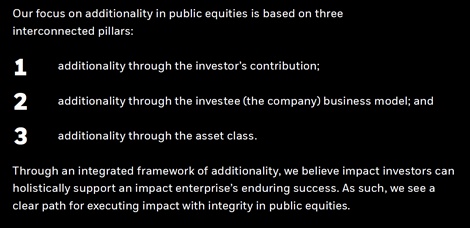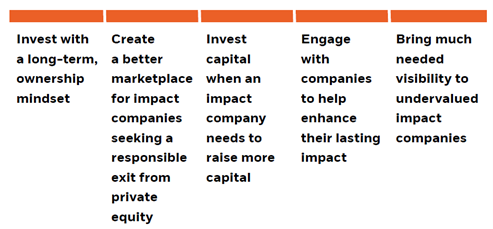Investing with Impact
By BlackRock


The case for impact investing in public equities
For a growing cohort of investors, financial returns aren’t enough. Those investors seek social and environmental progress in tandem with competitive investment performance. Impact investing through public equities provides an innovative mechanism to help realise their objectives. The origins of Impact Investments trace to microfinance where small loans funded micro enterprises such as farmers and entrepreneurs in remote villages. Today, venture capital and private equity impact strategies play a critical role in building impact businesses across industries and geographies.
However, the structure of private investing has prohibitive characteristics, including limited scalability and limited access to such investments for most investors. Public equities play a unique and complementary role in the impact investment ecosystem, offering potential solutions that private markets cannot and allowing more investors to participate in a space long available only to high-net-worth and institutional investors.
With the goal to achieve investment objectives while advancing our collective ability to address the great problems in the world, we evaluate some key points in the impact investing discussion and offer an integrated framework for impact investing in public equities.
Definition of Impact Investing1
Impact investments are investments made with the intention to generate positive, measurable social and environmental impact alongside a financial return. The practice of impact investing is further defined by core characteristics:
- Intentionality
Impact investing is marked by an intentional desire to contribute to measurable social or environmental benefit.
- Use of evidence and impact data in investment design
Impact investing needs to use evidence and data where available to drive intelligent investment design that will be useful in contributing to social and environmental benefits.
- Manage impact performance
Impact investing necessitates that investments be managed towards a specific intention. This includes having feedback loops in place and communicating performance information to support others in the investment chain to manage towards impact.
- Contribute to the growth of the industry
Investors with credible impact investing practices use shared industry terms, conventions, and indicators for describing their impact strategies, goals, and performance. They also share learnings where possible to enable others to learn from their experience as to what actually contributes to social and environmental benefit.
Additionality and impact
We believe an impact investing strategy in public markets should be based on the foundational concept of “additionality.” Additionality in this context means that but for this contribution, that outcome would not have occurred, thereby creating impact. It’s key to the impact approach.

1. Additionality through the Investor’s Contribution
Public market impact investors can adopt five best practices to create impact:


2. Additionality through the Company
A business qualifies as impact only if it meets the criteria of materiality and additionality. We typically define materiality as having greater than 50% of a company’s revenues from products and services helping to solve a major social or environmental problem, as represented by our impact themes and the United Nations Sustainable Development Goals (SDGs)2 and underlying targets.
To meet the additionality criterion, a company’s products or services must address a need that is unlikely to be fulfilled by others (such as competitors or governments). The primary sources of company additionality are the application of leading technologies or innovative business models, as well as the delivery of a company’s products to underserved populations. By requiring additionality for impact companies, we are effectively investing in disruptive innovation helping to meet essential needs where there is strong demand but inadequate supply.
Impact company example
Headquartered in the U.S., this global provider of quality educational services teaches more than 875,000 students in underserved communities, operating primarily in emerging markets and serving the lower socio-economic population.
In the last calendar year, the company also provided $750 million in scholarships, increasing access to education. The company is a Certified B Corporation® and Public Benefit Corporation (PBC). Through its education programs and vocational training for career advancement, we believe this company advances multiple Sustainable Development Goals (Quality Education and Reduced Inequalities) and underlying Targets as outlined below:
- Target 4.3: Ensure equal access for all women and men to affordable quality technical, vocational, and tertiary education, including university
- Target 4.4: Substantially increase the number of youth and adults who have relevant skills, including technical and vocational skills, for employment, decent jobs, entrepreneurship
- Target 10.1: Progressively achieve and sustain income growth of the bottom 40 percent of the population
- Target 10.2 Empower and promote the social, economic and political inclusion of all, irrespective of age, sex, disability, race, ethnicity, origin, religion or economic or other status
3. Additionality through the asset class
Quite simply, the global need for impact capital is an order of magnitude greater than what could conceivably be provided by the private markets. For developing markets alone, we face a shortfall of approximately US$2.5 trillion annually to meet the SDGs by 2030.3 Moreover, existing contributions from companies, governments and other organisations are not nearly enough to meet this need.
Given the magnitude of the need and the extraordinary opportunity, we must find ways for public markets to scale impact investing with integrity. By offering impact investing through public equities, a broad new cohort of investors can participate and provide much needed capital. It is long past time for the democratisation of impact investing.
End
References:
[1] The Global Impact Investment Network (GIIN)
https://thegiin.org/impact-investing/need-to-know/#what-is-impact-investing
Accessed March 2020.
[2] UNPRI – https://www.un.org/sustainabledevelopment/
[3] World Investment Report,” United Nations Conference on Trade and Development, 2014
Note: This article is a shorter version of a more detailed article published by Blackrock which can be found here:
Disclaimer
Risk Warnings
Capital at risk. The value of investments and the income from them can fall as well as rise and are not guaranteed. Investors may not get back the amount originally invested. Past performance is not a reliable indicator of current or future results and should not be the sole factor of consideration when selecting a product or strategy. Changes in the rates of exchange between currencies may cause the value of investments to diminish or increase. Fluctuation may be particularly marked in the case of a higher volatility fund and the value of an investment may fall suddenly and substantially. Levels and basis of taxation may change from time to time.
Important Information
This material is for distribution to Professional Clients (as defined by the Financial Conduct Authority or MiFID Rules) only and should not be relied upon by any other persons. From 1 January 2021, the issuer of this material is: BlackRock (Netherlands) B.V. for in the European Economic Area,
BlackRock (Netherlands) B.V. is authorised and regulated by the Netherlands Authority for the Financial Markets. Registered office Amstelplein 1, 1096 HA, Amsterdam, Tel: 020 – 549 5200, Tel: 31-20-549-5200. Trade Register No. 17068311 For your protection telephone calls are usually recorded.
Any research in this document has been procured and may have been acted on by BlackRock for its own purpose. The results of such research are being made available only incidentally. The views expressed do not constitute investment or any other advice and are subject to change. They do not necessarily reflect the views of any company in the BlackRock Group or any part thereof and no assurances are made as to their accuracy.
This document is for information purposes only and does not constitute an offer or invitation to anyone to invest in any BlackRock funds and has not been prepared in connection with any such offer.
© 2021 BlackRock, Inc. All Rights reserved. BLACKROCK, BLACKROCK SOLUTIONS, iSHARES, BUILD ON BLACKROCK and SO WHAT DO I DO WITH MY MONEY are trademarks of BlackRock, Inc. or its subsidiaries in the United States and elsewhere. All other trademarks are those of their respective owners.
